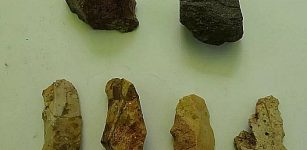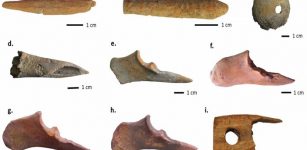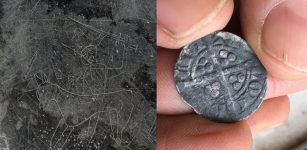On This Day In History: Thor Heyerdahl Sails From Morocco On Papyrus Boat Ra II To Barbados – On May 17, 1970
AncientPages.com - On May 17, 1970, the reed boat Ra II with Thor Heyerdahl, accompanied by an international crew, set sail from Safi in Morocco on course for Barbados.
Thor Heyerdahl in front of the raft RA11 before the second attempt to crush the Atlantic. The picture was taken in Morocco, date unknown. Photo: Michel Lipchitz/AP
With this expedition, Thor Heyerdahl (1914 – 2002) wanted to prove that one could have used this type of vessel to cross the Atlantic Ocean in ancient times.
Ra II's vessel was built of papyrus by Demetrio, Juan, and Jose Limachi from Lake Titicaca in Bolivia and based on drawings and models from Ancient Egypt.
A year earlier, Heyerdahl built a 45-foot-long copy of an ancient Egyptian papyrus vessel with the aid of traditional boat builders from Lake Chad in Central Africa.
Named after the sun god Ra, the boat was transported to Safi in Morocco, from where it set sail for the Caribbean on May 24, 1969. Defects in design and other sailing problems caused it to founder in July, 600 miles short of its goal.
It had sailed 3,000 miles and had almost made it across the Atlantic Ocean. This time, the expedition was successful.
After a voyage of 57 days and 4,000 miles, the ship arrived in Barbados. The story of this voyage is recorded in the book The Ra Expeditions (1971) and a documentary film.
Additionally, the expedition took samples of marine pollution and presented their report to the United Nations.
Thor Heyerdahl was a Norwegian adventurer and ethnographer with a zoology, botany, and geography background. He led the famous Kon-Tiki (1947) and Ra (1969–70) transoceanic scientific expeditions. Both expeditions were intended to prove the possibility of ancient transoceanic contacts between distant civilizations and cultures.
The Ra II in the Kon-Tiki Museum. Image credit: Ralf Roletschek - CC-BY-SA via source
For the most part, Heyerdahl's theories have not been accepted by anthropologists. Late in 1977, Heyerdahl and an international crew embarked upon the Tigris expedition, a four-month, 4,000-mile voyage in a craft made of reeds.
The expedition began on the Tigris River in Iraq, traveled down the Persian Gulf, across the Arabian Sea to Pakistan, and ended in the Red Sea. The goal of the Tigris expedition was to establish the possibility that the ancient Sumerians might have used similar means to spread their culture through southwest Asia and the Arabian Peninsula.
The voyage was recorded in Heyerdahl's book The Tigris Expedition (1979) and a documentary film. He subsequently led research expeditions to the Maldive Islands, Easter Island, and an archaeological site in Peru.
The Ra II is now in the Kon-Tiki Museum in Oslo, Norway.
AncientPages.com
More From Ancient Pages
-
 İnkaya Cave Study Brings To Light 86,000-Year-Old Traces Of Human Life
Archaeology | Aug 22, 2023
İnkaya Cave Study Brings To Light 86,000-Year-Old Traces Of Human Life
Archaeology | Aug 22, 2023 -
 Attila The Hun: The Destroyer Of Rome Among Most Fearsome Enemies The Empire Ever Faced
Featured Stories | Jun 24, 2019
Attila The Hun: The Destroyer Of Rome Among Most Fearsome Enemies The Empire Ever Faced
Featured Stories | Jun 24, 2019 -
 Discovered Roman Malting Oven Could Be Evidence Of 2,000-Year-Old Beer Production In The UK
Archaeology | Apr 4, 2022
Discovered Roman Malting Oven Could Be Evidence Of 2,000-Year-Old Beer Production In The UK
Archaeology | Apr 4, 2022 -
 House Of Borgia – The Most Infamous Family Of Renaissance Italy
Featured Stories | Feb 28, 2019
House Of Borgia – The Most Infamous Family Of Renaissance Italy
Featured Stories | Feb 28, 2019 -
 Spectacular Fengdu Ghost City Devoted To Afterlife
Chinese Mythology | Aug 22, 2016
Spectacular Fengdu Ghost City Devoted To Afterlife
Chinese Mythology | Aug 22, 2016 -
 Zoroaster’s Doomsday Prophecy About Comet Gochihr And Its Similarity With The Apocalypse Of John In The Book Of Revelation
Biblical Mysteries | Aug 17, 2017
Zoroaster’s Doomsday Prophecy About Comet Gochihr And Its Similarity With The Apocalypse Of John In The Book Of Revelation
Biblical Mysteries | Aug 17, 2017 -
 Evidence Of Yue – Ancient Chinese Criminal Punishment Found At Sanmenxia City
Archaeology | May 17, 2024
Evidence Of Yue – Ancient Chinese Criminal Punishment Found At Sanmenxia City
Archaeology | May 17, 2024 -
 First Early Roman Fortlet Found On The Isle of Anglesey, North Wales
Archaeology | Nov 26, 2015
First Early Roman Fortlet Found On The Isle of Anglesey, North Wales
Archaeology | Nov 26, 2015 -
 Undeciphered Ancient Code Could Be Evidence Of The World’s Oldest Data Storage System
Archaeology | Feb 27, 2014
Undeciphered Ancient Code Could Be Evidence Of The World’s Oldest Data Storage System
Archaeology | Feb 27, 2014 -
 Evidence Hominins Were Present In Europe Far Earlier Than Previously Thought
Human Beginnings | Jan 28, 2025
Evidence Hominins Were Present In Europe Far Earlier Than Previously Thought
Human Beginnings | Jan 28, 2025 -
 More Sophisticated Manufacturing In The Bronze Age – New Evidence
Archaeology | Jun 27, 2020
More Sophisticated Manufacturing In The Bronze Age – New Evidence
Archaeology | Jun 27, 2020 -
 The Untold Story Of Sacsayhuamán – Falcon’s Place Is Not What It Seems
Ancient Mysteries | Apr 28, 2020
The Untold Story Of Sacsayhuamán – Falcon’s Place Is Not What It Seems
Ancient Mysteries | Apr 28, 2020 -
 On This Day In History: Great Sheffield Flood – Largest Man-Made Disaster Occurred In England – On Mar 11, 1864
News | Mar 11, 2017
On This Day In History: Great Sheffield Flood – Largest Man-Made Disaster Occurred In England – On Mar 11, 1864
News | Mar 11, 2017 -
 ‘Liber Linteus’ – Unique History Of Ancient ‘Linen Book’ Written In Etruscan That Still Remains Poorly Understood
Artifacts | Oct 21, 2019
‘Liber Linteus’ – Unique History Of Ancient ‘Linen Book’ Written In Etruscan That Still Remains Poorly Understood
Artifacts | Oct 21, 2019 -
 Kizilkoyun Necropolis: Excavations Of 2,000-Year-Old Rock Tombs Will Solve Mysterious Past Of Göbeklitepe
Archaeology | Sep 7, 2020
Kizilkoyun Necropolis: Excavations Of 2,000-Year-Old Rock Tombs Will Solve Mysterious Past Of Göbeklitepe
Archaeology | Sep 7, 2020 -
 Mada’in Saleh: Spectacular Rock-Cut Tombs And Monuments Reflect Great Skills Of Nabataean Builders
Featured Stories | Aug 18, 2020
Mada’in Saleh: Spectacular Rock-Cut Tombs And Monuments Reflect Great Skills Of Nabataean Builders
Featured Stories | Aug 18, 2020 -
 Rare Viking Graffiti And Artifacts Found In Dublin – Depiction Of God Odin Riding Sleipnir Followed By Huginn And Muninn?
Archaeology | Mar 31, 2018
Rare Viking Graffiti And Artifacts Found In Dublin – Depiction Of God Odin Riding Sleipnir Followed By Huginn And Muninn?
Archaeology | Mar 31, 2018 -
 Jamukha: Mongolian Leader, Military And Childhood Friend Of Genghis Khan But Not Forever
Featured Stories | May 8, 2019
Jamukha: Mongolian Leader, Military And Childhood Friend Of Genghis Khan But Not Forever
Featured Stories | May 8, 2019 -
 Mask Of Shame: Worn In Ancient Times As Punishment For Gossiping
Ancient History Facts | Jan 5, 2017
Mask Of Shame: Worn In Ancient Times As Punishment For Gossiping
Ancient History Facts | Jan 5, 2017 -
 Sacred Number Four – Perfect Number And Deep Meaning Behind It
Ancient Symbols | Nov 7, 2017
Sacred Number Four – Perfect Number And Deep Meaning Behind It
Ancient Symbols | Nov 7, 2017



